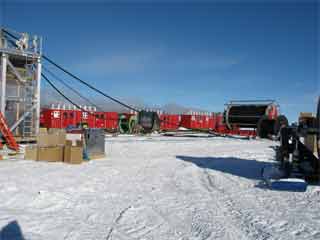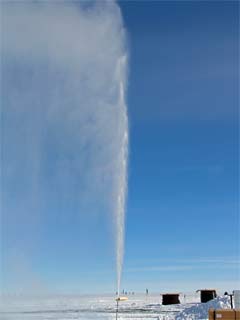2005-06 Summer Photos - IceCube
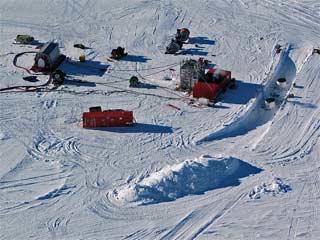 The center of drilling activity--the drill tower, hose reels, and (to the right of the drill tower) two IceTop tanks. Two of these tanks are to be installed adjacent to each drill hole; two digital optical modules (DOMs, identical to the ones placed in the drill holes) are installed in each water-filled tank. The tanks are then allowed to freeze, slowly and carefully (JY). |
 Another drilling setup, this one is adjacent to the drill camp (seasonal operations site, SES) which houses the generators, pumps, and all of those souped-up car-wash hot water heaters. A Rodriguez well is drilled at each camp location to provide all of that water. AST/RO and MAPO are visible at the top of this photo (FB). |
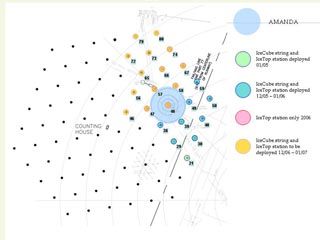 Here's a status map of completed strings/tanks, along with updated plans for the 2006-07 season--now the IceTop tank deployments will be backed off to not exceed the planned drill string locations (AK) (the original FY07 plan (JY)). |
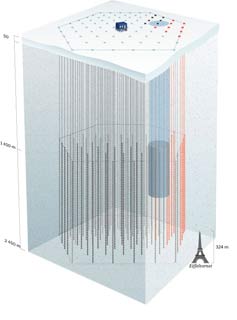 Another status graphic, this one in 3 dimensions shows the current and planned size of this cubic kilometer sized telescope. The red lines are the completed strings; the dark cylinder represents the older AMANDA strings (JY). |
 The drill tower. There are two of these structures--while one is in use, the second one is being positioned at the next drill site (SK) |
|
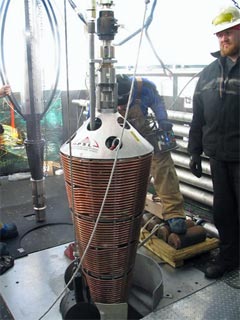 Here's the firn drill, used to go down the first 160 feet or so. "Firn" is the surface snow that hasn't yet been compacted to a uniform ice density. The firn drill is a cone with leaky copper tubing through which hot water is pumped, it basically sinks from its own weight (JC). |
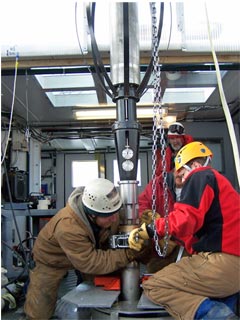 Next, here's the main hot water drill that goes down the rest of the way (AK). |
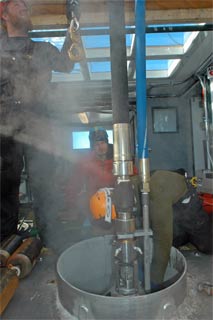 Here are the hose connections to the top of the drill. It uses 250 GPM of 190°F water at 950 psig. The large black supply hose also must support the weight of the drill string, so it had to be specially designed for all of these extreme conditions. The blue hose is the return line. Typically the drill descends about 5 feet per minute (TG). |
 Here a logger is being sent down a freshly drilled hole to measure its characteristics. This is James Latshaw, a 2004 and 2005 winterover who returned after R&R to work on the drilling crew (SP). |
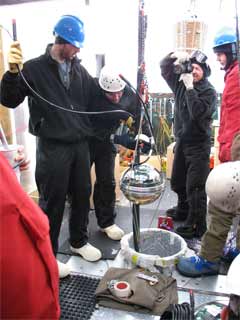 Last step, hanging the DOMs on support/ data cables and making connections. This must be done quickly as the hole will start to freeze in 24 hours. It takes about 12 hours to install and lower the 60 DOMs. The data connectors can be the weak link in the system...at present about 2% of the DOMS are nonfunctional (SK). Last step, hanging the DOMs on support/ data cables and making connections. This must be done quickly as the hole will start to freeze in 24 hours. It takes about 12 hours to install and lower the 60 DOMs. The data connectors can be the weak link in the system...at present about 2% of the DOMS are nonfunctional (SK). |
|
|
During the first season (2004-05), one drill string and four pairs of IceTop tanks were installed. In 2005-06, 8 additional holes/ strings were installed, along with 12 pairs of IceTop tanks. 2006-07 plans include 12 or more strings; the team hopes to increase the output based on experience and equipment improvements, so the goal is still 70+ holes. Photo credits: Albrecht Karle (AK) presentation, Jeff Cherwinka (JC) presentation, Jim Yeck (JY), Forrest Banks (FB), Denis Barkats (DB); as well as Steven Profaizer (SP), Spencer Klein (SK), and Thomas Gustafsson (TG) from the USAP photo library. This material is based upon work supported by the National Science Foundation under Grant Nos. OPP-9980474 (AMANDA) and OPP-0236449 (IceCube), University of Wisconsin-Madison. Nearby, there were lots of things happening at DSL.... | |
